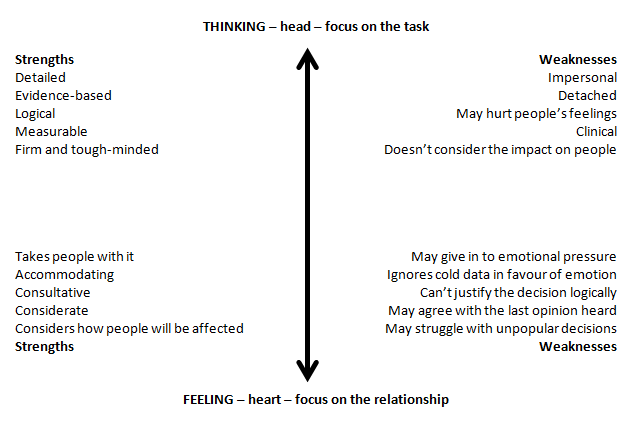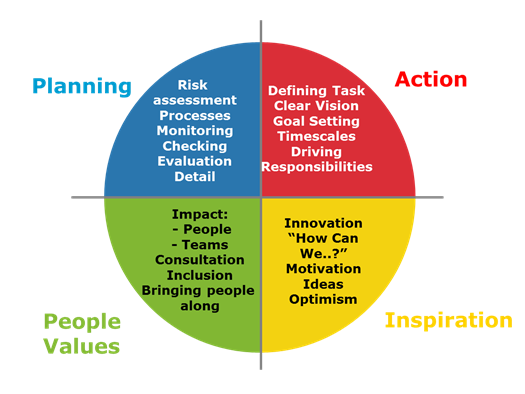By Giles Miskin
Giles Miskin is a leadership development expert focussing on behaviours. He is a regular speaker at Academy Groups and his energetic, intelligent and engaging style stimulates conversation and change. He is Managing Director of The Colour Works (www.thecolourworks.com), a progressive learning and development company specialising in transforming leadership and team-working performance, inspiring people to deliver better results.
When psychologist Carl Jung described the behavioural differences between people in his 1921work ‘Psychological Types’, he drew a continuum between those with a preference for “Thinking” on one end and “Feeling” on the other, with specific reference to how each approaches the decision-making process.
Of course, we can sit anywhere along this spectrum and there is no right or wrong position (although we tend to believe that our way is both normal and best!). Each position has both strengths and weaknesses, as per the model below:
 Most of us will have experienced, or been on the receiving end of, what we perceive to be “bad” decision-making. In most cases, what that means is “not how I would have gone about it” – too hard-nosed, too accommodating, too rash, too slow, etc – i.e. whatever I’m not.
Most of us will have experienced, or been on the receiving end of, what we perceive to be “bad” decision-making. In most cases, what that means is “not how I would have gone about it” – too hard-nosed, too accommodating, too rash, too slow, etc – i.e. whatever I’m not.
Most of us also sit somewhere in between the two extremes of Thinking and Feeling, with a foot in both camps – “My head says do X and my heart says Y” – and whilst this might appear to enable a more balanced approach, it by definition misses out on the strengths associated with either extreme.
Consider, for example, how you would approach the following scenario. A long-standing and well-respected male Team Leader is found to have a drug habit. It doesn’t appear to have affected either the quality of his work or his working relationships, though you don’t know who else in the company knows. What do you do?
The high-end Thinker might say: “clear breach of the rules, a risk to the company’s reputation, health and safety nightmare, must be seen to be tough, get rid!” The high-end Feeler might say: “he has served the company well, is admired by his staff and deserves our support. We need to listen to him and understand his situation and be careful of a staff backlash to overly harsh treatment.”
So, what would robust decision-making look like in this instance? Well, almost certainly a combination of the two. Every aspect needs to be considered. This, of course, does not make the eventual decision any easier, but a) that’s what we’re paid for, b) any decision is better than none and c) making the decision itself is not the end of the process as how it is implemented – communicating it and managing the fall-out – is just as important.
What, then, would be a recommended way of approaching challenging decisions? Well, although none of us would typically approach the process with the Thinker-Feeler divide in our minds, the Insights colour model of behaviour makes Jung’s theories accessible and memorable and raises these important behavioural differences to a level of consciousness whereby we can use them to our advantage. So:
Know yourself, warts ‘n’ all. Whatever your combination of colour preferences – Fiery Red (extraverted thinking), Cool Blue (introverted thinking), Earth Green (introverted feeling), Sunshine Yellow (extraverted feeling) – you will have tendencies towards one end of the spectrum or the other, with all of its associated strengths and weaknesses.
Get input from your Opposite Types. This will challenge your approach and push you into working through the decision from different perspectives. Better still if you have people at both extremes.
Go around the colour wheel. As you go through the decision-making process, check in with each of the colour energies to ensure you’re seeing the issue from the perspective of each. See below to see what each colour brings to the decision-making process:
Once the decision has been reached, a) ensure there is absolute clarity amongst the top team and that everyone is on board, then b) agree to whom, by whom, how and by when the decision will be communicated.
Tailor the message to the needs of the recipient. Again, the colour model is useful here as the colour preferences of the recipient will determine the best way (language, tone, environment) of communicating the decision to ensure they stay engaged and on-side. For example:
- Cool Blue – show your reasoning, give written evidence, use logic and follow the rules
- Earth Green – be relaxed, make them feel comfortable, keep on a one-to-one basis, show you care
- Sunshine Yellow – keep focused on future possibilities, draw pictures, tell stories, stay friendly
- Fiery Red – be clear, concise, factual and assured.

